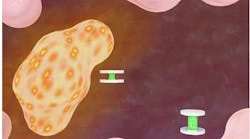Researchers at the National Institute of Standards and Technology (NIST) and the National Institutes of Health (NIH) have devised and demonstrated a shape-shifting probe—about one-hundredth as wide as a human hair—that can carry out high-resolution remote biological sensing not possible with current technology.
To date, most efforts to image highly localized biochemical conditions inside patients (such as abnormal pH and ion concentration, which are indicators for many disorders) rely on nanosensors that are placed in tissues and specimens, then probed using light at optical frequencies. But the sensitivity and resolution of the resulting optical signals decrease with increasing depth into the body. That limits most nanosensors to working in less obscured, more optically accessible regions.
The new shape-shifting probe devices can detect and measure localized conditions on the molecular scale deep within tissues, observing changes in real time. They operate in the radio frequency spectrum, making them detectable with standard nuclear magnetic resonance (NMR) or magnetic resonance imaging (MRI) equipment.
In these RF ranges, signals are not appreciably weakened by intervening biological materials. As a result, they can get strong, distinctive signals from small locales at substantial depths or in other locations impossible to probe with optically based sensors.
Watch a video on the sensors, curated by Engineering TV, below:
The novel devices, called geometrically encoded magnetic sensors (GEMs), are microengineered metal-gel sandwiches about 5 to 10 times smaller than a single red blood cell, one of the smallest human cells. Each consists of two magnetic disks that range from 0.5 to 2 micrometers in diameter and tens of nanometers thick.
A layer of hydrogel between the disks can absorb water, either expanding significantly or shrinking in response to changing local conditions. Swelling or shrinking of the gel changes the distance and, therefore, the magnetic field strength, between the disks. That, in turn, changes the frequency at which the protons in water molecules around and inside the gel resonate in response to radio-frequency radiation. Scanning the sample with a range of frequencies quickly identifies the current shape of the nanoprobes, effectively measuring remote conditions through the changes in resonance frequencies caused by the shape-changing agents.
The researchers tested the sensors in solutions of varying pH, in solutions with ion concentration gradients, and in a liquid growth medium containing living canine kidney cells as their metabolism went from normal to nonfunctional in the absence of oxygen. That phenomenon caused the growth medium to acidify, and the change was detected by the GEMs and recorded through real-time shifting in resonant frequencies.
GEMs can also be “tuned” during fabrication to respond to different biochemical states and resonate in different parts of the RF spectrum by altering the gel composition, the magnet shapes, and materials. This means researchers could place two different types of GEMs at the same site to track changes in two different variables at the same time.
One long-term goal for the research team is to improve techniques so GEMs can be employed for biomedical uses. That would require, among other things, further miniaturization. The current GEMs measure 0.5 to 2 µm in diameter GEMs and are small enough for many in vitro and other possible non-biological applications. But preliminary estimates indicate the sensors can be reduced substantially from their current size, and might conceivably be made smaller than 100 nanometers in diameter. That would open up many additional biomedical applications.
Another goal is to develop dimensionally controlled, large-scale fabrication processes so that the sensors can be widely available to researchers.
If put into widespread use, the sensors could be of value for research into medicine, engineering, and biology, and be used in clinical diagnostics.
